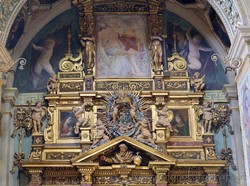|
Church of Santa Maria Assunta Al Vigentino
|
|
|
Show an other treasure of art and history in Milan:
|
 Mostly represented styles: Baroque Mostly represented styles: Baroque
Another treasure of art and history in Milan, which is almost completely unknown, even to most of the inhabitants of Milan, is the Church of Santa Maria Assunta in Vigentino, located in the extreme southern periphery of the city, in the Vigentino quarter, an independent municipality until 1923.
It is worth mentioning that the village of Vigentino was one of the collection points of the Milanese refugees after the destruction of the city by Federico Barbarossa in 1162.
In the fifteenth century, the nearby monastery of Castellazzo represented a pole of the Observance to the rule of San Gerolamo for the whole Europe, home to the legendary humanist library of Archbishop Francesco Pizolpasso and the pivot of an ideal space according to the model of Castiglione Olona.
From at least half of the sixteenth century it became a parish church.
At the end of the sixteenth century, the original church was replaced with the present one. The reconstruction took place largely during Bernardo Borroni's rectorate. He not only managed it, but he also financed it in a not small part. His figure appears in one of the paintings of the Marian cycle in the presbytery. The reconstruction, in Baroque style, could be said to be completed in 1621.
The present church has a single nave, with three chapels per side. From the artistic point of view, the most important one is that of the Rosary, the last on the left (Fig. 5). It is dominated by a large gold-plated, four-level carved wood structure. At the top of it in the center there is a fresco of a Pietà from the 16th century, unfortunately not in very good state of conservation. To the left of it a painting of Santa Maria Maddalena, to the right one of Santa Marta.
At the center of the structure, in a niche, there is a statue of the Madonna with, on the left, a painting of Saint Domenico of Guzman and on the right one of San Carlo.
On the walls of the chapel the Mysteries of the Rosary and some saints are then portrayed by the Cerano workshop.
There are furthermore three stylistically homogeneous chapels (one of them dedicated to San Gerolamo, Fig. 7, and one dedicated to San Carlo, Fig. 8), the two toward the altar on the right and the central one on the left side. Made in the sixteenth century, in all of them you find columns of fake smooth black marble with a tympanum at the top. In each of the two niches above the chapels arches there is an angel, while at the top of the arch there is a cherub head.
The chapel vaults are decorated with stuccoes and frescoes. It is not excluded that also in this case the artists of the Cerano workshop where involved.
The first chapel on the left, doing the baptistery functions, is instead of the eighteenth century. On its wall there is a fresco of the Baptism of Christ by Giovanni Battista Sassi.
Of the seventeenth century is also the great baroque altar in polychrome marbles, characterized by the presence of two large lacquered terracotta statues of angels and of an imposing tabernacle with at the top of it a statue of the resurrected Christ. Very beautiful also the base in scagliola, perhaps coming from another church.
Important additions and modifications date back to the nineteenth and twentieth centuries. In particular:
- In the second half of 1800, a new organ was placed on the counterfacade
- Between 1900 and 1901 the façade was rebuilt, and unfortunately the old statues were eliminated, replaced by new ones, of St. Charles and St. Bernard of Chiaravalle in the niches and of Our Lady and of angels playing the trumpet on the upper border of the facade (according to the model of those on the facades of the Church of Santa Maria dei Miracoli at San Celso in Milan and of the Sanctuary of the Blessed Virgin of the Miracles in Saronno.
- An extra arm was added on the left.
- The frescoes on the vault of the nave and of the presbytery and the frames that surround them date back to the 60's of the twentieth century. You don't notice it easily because they were made by simulating the eclectic style in vogue at the end of the nineteenth century. Scenes from Maria's life are depicted in chronological order starting from the entrance and going to the bottom.
A dedicated discussion deserves the Marian cycle in the presbytery. It includes three large canvases from the early seventeenth century, depicting the terminal episodes of the life of Our Lady and placed in sumptuous baroque stucco frames: Death (Dormitio), Ascension and Coronation of Mary. They were commissioned by the formerly named parson Bernardo Borroni himself (who is not accidentally depicted in the painting showing the coronation, Fig. 4, left painting, character dressed in black and with folded hands).
The author of the three beautiful canvases is not known for sure, although the style is clearly very close to that of Giovanni Ambrogio Figino.
The other two paintings in the presbytery are worth mentioning, added only at the end of the nineteenth century, but from the seventeenth century (Fig. 3, the two exterior paintings): on the left an Adoration of the Magi and on the right the Martyrdom of Sant'Eurosia, protector against lightnings.
Finally, the bell tower, rebuilt at the end of 700 in its upper part.
The Church of Santa Maria Assunta Al Vigentino is in Dell'Assunta Square.
If you are interested in a guided tour of this monument send an email!
Categories: Churches / Religious buildings
45.433568, 9.2028879 |
Further pictures of the Church of Santa Maria Assunta Al Vigentino in the section Photography |